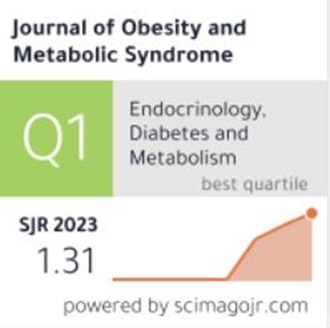Letter: Triglyceride-Glucose Index Predicts Cardiovascular Outcome in Metabolically Unhealthy Obese Population: A Nationwide Population-Based Cohort Study (J Obes Metab Syndr 2022;31:178-86).
IF 7.9
Q1 ENDOCRINOLOGY & METABOLISM
引用次数: 0
Abstract
J Obes Metab Syndr 2023;32:179-180 Cardiovascular diseases (CVDs) are the most common cause of physical disability and mortality globally1 and the second leading cause of death in Korea.2 Hence, determining predictors of CVD is crucial to promoting human health. Currently, traditional cardiovascular (CV) risk factors are used in CVD prediction models.3 In addition to diabetes mellitus (DM), insulin resistance is the fundamental etiology of atherosclerotic CVD and is used to predict CVD in both people with and without DM.4 The gold standard for diagnosis of insulin resistance is the euglycemic insulin clamp technique; however, this method is complex, invasive, and costly.5 The homeostasis model assessment-estimated insulin resistance index is widely used owing to its convenience; only one blood sample is required. However, it has the following drawbacks: (1) blood insulin concentration must be measured; (2) it cannot be used for individuals receiving insulin therapy; and (3) it is inaccurate in patients with DM with diminished beta-cell function.6 The triglyceride-glucose (TyG) index overcomes these drawbacks. It is calculated using fasting glucose and triglyceride levels and can be used to indicate insulin resistance in people with and without DM.7 Cho et al.8 classified 292,206 participants of the Korean National Health Insurance Service National Health Screening Cohort into four groups (metabolically healthy non-obese, metabolically unhealthy non-obese, metabolically healthy obese [MHO], and metabolically unhealthy obese [MUO]) that were followed from 2009 to 2015. The baseline TyG index was found to be correlated with CV events and CV mortality in the MUO group. However, this study analyzed the correlation between baseline TyG index and the incidence of CVD over 6 years of follow-up. Changes in the TyG index during the follow-up period may have influenced the gradual onset of CVD. Therefore, predicting CVD based on TyG index taken at one time point may be inaccurate and vulnerable to regression dilution biases.9 Furthermore, Cho et al.8 divided the participants into groups based on obesity and metabolic health at baseline to investigate CV events and mortality throughout the follow-up period. Obesity and metabolic health also change over time. Soriguer et al.10 reported that many study participants progressed from MHO to MUO during a 6or 11-year of follow-up. Furthermore, the incidence of type 2 DM decreased among individuals who lost weight during the follow-up period. Thus, obesity and metabolic health are dynamic and change over time, and ultimately,甘油三酯-葡萄糖指数预测代谢不健康肥胖人群的心血管结局:一项全国性的基于人群的队列研究(J Obes Metab Syndr 2022;31:178-86)。
本文章由计算机程序翻译,如有差异,请以英文原文为准。
求助全文
约1分钟内获得全文
求助全文
来源期刊

Journal of Obesity & Metabolic Syndrome
ENDOCRINOLOGY & METABOLISM-
CiteScore
8.30
自引率
9.60%
发文量
39
审稿时长
19 weeks
期刊介绍:
The journal was launched in 1992 and diverse studies on obesity have been published under the title of Journal of Korean Society for the Study of Obesity until 2004. Since 2017, volume 26, the title is now the Journal of Obesity & Metabolic Syndrome (pISSN 2508-6235, eISSN 2508-7576). The journal is published quarterly on March 30th, June 30th, September 30th and December 30th. The official title of the journal is now "Journal of Obesity & Metabolic Syndrome" and the abbreviated title is "J Obes Metab Syndr". Index words from medical subject headings (MeSH) list of Index Medicus are included in each article to facilitate article search. Some or all of the articles of this journal are included in the index of PubMed, PubMed Central, Scopus, Embase, DOAJ, Ebsco, KCI, KoreaMed, KoMCI, Science Central, Crossref Metadata Search, Google Scholar, and Emerging Sources Citation Index (ESCI).
 求助内容:
求助内容: 应助结果提醒方式:
应助结果提醒方式:


